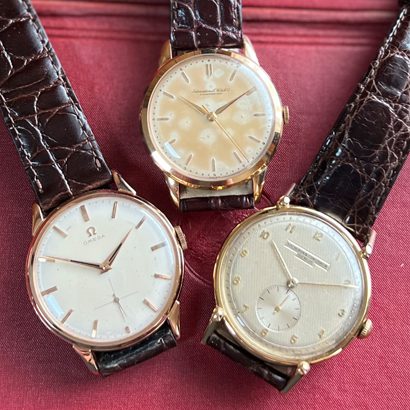THE BEST VINTAGE WATCHES
FROM THE MID-20TH CENTURY
The 20th century was a time of outstanding pioneering watch houses, and the cutting-edge watches they produced were both prolific in number and highly innovative. With so many exceptional watchmaking houses and even more breathtaking watches and models, selecting and investing in the best vintage watch for you can be a minefield.
While it’s true that there are more zirconias than diamonds in the vintage watch market, this shouldn’t fill you with dread. Knowing the watch models that are all-time classics can steer you towards the gems and keep you away from the duds. Pair that knowledge with solid support from a reputable vintage watch dealer, and you’re on the right track.

Defining the Best Vintage Watches
The world of vintage watches is vast, so choosing a handful of the all-time best vintage watches from the 20th century may seem somewhat reductionist. For this exercise, we sharpened our gaze on vintage watches from the golden age of watchmaking, the 1950s – 1970s.
The mid-20th century saw the greatest engineering advances in terms of reliability, robustness and accuracy. The First and Second World Wars resulted in much greater spending on R&D than ever before. Advances in shockproofing, waterproofing, and anti-magnetic watches gave rise to many of the watch models we know and love today.
Our list of the best vintage watches from the golden era of watchmaking is made up of a range of price points, but most models fall under the range of £3,000 to £7,000. While we appreciate that this may not seem affordable for many, we feel that this price point is reasonable for a vintage watch that is practical, robust, sought-after and celebrated for its engineering achievements and historical relevance.
Let’s explore some of the best vintage watches from that period.

Early Patek Philippe Calatrava’s
Almost since its inception, Patek Philippe has been considered the pinnacle of watchmaking, and the Calatrava is the most significant watch model in the company’s history for three principal reasons: Firstly, from its launch in 1932, the Calatrava quickly became a cornerstone for Patek and has remained so to this current day.
Secondly, the design has become ‘the blueprint’ for today’s modern ‘time only’ dress watch. Thirdly, it helped re-establish and re-position the brand during a time when it was transitioning from a one-off or very small number manufacturing company to the serial production of wristwatches.
Upon its launch, the Patek Philippe Calatrava was considered so exceptional it was given a name rather than simply a model number. This was a significant first for Patek, and further, it was named after the Calatrava Cross, which has been the company’s brand and trademark since 1887.
The Patek Philippe Calatrava design was created during the early 1930s when gentlemen’s wristwatches were still a relatively new phenomenon. However, wristwatches were gaining popularity following their use by Officers during World War I.
Inspired by the Bauhaus principle of form follows function, the minimalist design created by David Penney distilled timekeeping down to its purest essence. The Calatrava was launched in 1932 with the model reference 96, with the look we have all become so familiar with.
You may feel it is somewhat unremarkable today, but this is because the Calatrava Reference 96 is the design standard today. In 1932, there was nothing else like it, characterised by its pure lines, round case, supreme elegance and timeless, understated perfection. Its significance to design and watchmaking cannot be understated.
3 examples of the Patek Philippe Calatrava…

1950’s Rolex Oyster Perpetual Bubbleback
Rolex is the most collected brand, and the Oyster Perpetual, the first commercially successful waterproof automatic watch, is the main foundation on which the company was built. However all the early examples until 1950 are considered by most to be too small to actually wear and use today.
Then, in 1950, Rolex launched its revised model, which was larger and more robust. At 34 mm in diameter, the watch case was also quite deep and featured a ‘bubble back’ which was needed to cover the larger rotor and movement that turns on a pivot to set the hairspring in motion. Available in gold and steel, it became a hugely popular, aspirational watch.
The Oyster Perpetual sports dress watch is also the original design on which all Rolex automatics are based and has spawned a vast range of models. They were the first to feature Rolex’s inaugural self-winding movements, laying the foundation for the brand’s success.
Although the Bubbleback may not garner as much attention as some later vintage sports Rolex models, these early self-winding timepieces played a crucial role in Rolex’s evolution and so have gained notoriety and become much sought-after pieces for vintage watch lovers.
The success of the Bubbleback was hugely influential and played the most significant role in the growth of the company we know today, giving it substantial historical importance.
3 examples of the Rolex Oyster Perpetual Bubble Back…

Early and Mid-century Omega Seamaster
The third watch on our list are the early Omega Seamaster models. Introduced in 1948, The Seamaster and other models produced through to the mid-1960s make wonderful collectable watches.
The Seamaster was at the forefront of Omega’s technological advancements and featured anti-magnetism, waterproofing, and shock proofing capabilities, making it, still to this day, an outstanding and robust watch.
The first Seamaster introduced the o-ring gasket, a small rubber ring that tightly sealed the case back, to the commercial market. Rubber replaced lead to offer exceptional water resistance at a broader range of temperatures. All these features made it ideal for diving. However, it took until 1957 for the Seamaster 300 to be released and for the diving legend to be born, featuring a unidirectional rotating bezel and a black dial with luminous markers.
The Seamaster has decades of milestone achievements, world firsts and genuine World War ancestry. When the Seamaster was released, Omega had already provided over 100,000 watches to the Ministry of Defence, meaning the technology had been thoroughly war-tested. With multiple model variations released each year, we can find vintage Seamasters in a wide range of forms and dial arrangements, ensuring there’s a model to suit every individual’s unique style.
But it’s the early 1948 – 1958 watches that stand out as the most rare and captivating. These watches were primarily crafted in steel, although some were also made in solid gold, boasting numerous subtly differing dial variations. Today, they are available at various price points. Wearing a vintage Omega Seamaster offers excellent value for money and represents a solid investment opportunity.

Early Rolex Datejusts
Arguably, no watch has impacted Rolex’s enduring success more than the beloved Datejust. The Datejust, launched in 1945, was the world’s first self-winding wristwatch with an automatic date change function, setting the standard for date complications in wristwatches.
Rolex crafted the historic Datejust by combining two earlier innovations—the 1926 waterproof Oyster case and the 1931 self-winding Perpetual movement—and the brand new date display on the dial.
The name Datejust didn’t consistently appear on the dials until the mid-1950s and the Cyclops magnifier over the date window was also a later addition, introduced in 1955.
Since then, the Datejust has seen numerous variations, including two-tone steel and pink gold models, entirely steel versions, and some with stone dials or diamond bezels. During the 60s and 70s, the Datejust received several upgrades to its movement. In 1977, the calibre 3035 in the Ref. 16014 was introduced, significantly improving its frequency and accuracy.
However, it’s the earlier Datejust models from 1945 to 1954 that are the most sought-after due to their rarity and unique dial variations. Specifically, Ref 4467 and Ref. 6605 are highly desirable models. Produced mainly in steel and solid gold, these models are available at various price points, with the earlier, more rare models reaching loftier prices.
The Datejust is one of the oldest Rolex models remaining in production today, laying testament to the significance of this 20th-century design classic. Its significance extends beyond Rolex, shaping the watchmaking industry, and making it a solid choice as one of the best vintage watches from the mid-20th century.

High-Quality Chronographs From Omega or Jaeger-LeCoultre
We feel it’s important to include a high-quality chronograph from Omega or Jaeger-LeCoultre in this list. But choosing just one just didn’t seem fair as all the premium chronographs from Omega and Jaeger-LeCoultre produced in the mid-20th century are excellent watches.
Many manufacturers have made chronographs, but Omega and Jaeger-LeCoultre have produced some of the best. In terms of quality, these fall just short of those in the top tier from Patek and Vacheron, but their movements are of equal quality but much more affordable. For this reason, it is important to include this specific category.
Within this group of fine mid-20th century chronographs, there are many watches to highlight. Instead of listing them all, we offer a few examples that showcase the mid-20th century design and engineering prowess coupled with the chronograph feature.
For Omega, this includes the Centenary (1949), Cosmic (1951) and Automatic (1953), not forgetting the legendary Seamaster, Seamaster De Ville (1964) and the Speedmaster. To name a few. One example that we see above is an unrestored and untouched Omega Chronograph from 1948. Every aspect of this was in superb condition, from the 18ct yellow gold case, original silver-white, triple register dial and the freshly serviced calibre 321 chronograph movement, which is sparkling. Many consider the Cal.321 to be one of the best chronograph movements ever produced.
From Jaeger-LeCoultre, examples such as the one below showcase the minimalistic and elegant design of JLC from the mid-20th century. This particular watch is exceptional, not only for its quality, size and condition but also due to the fact that this is an Edmond Jaeger signed 18ct pink gold chronograph, which makes this a very rare watch indeed.
Other examples of notable mid-20th century JLC and Omega chronographs include…

Triple Calendar Moonphase Models From Omega and Jaeger-LeCoultre
The final entry for best vintage watches from the mid-20th century is another complication. The triple date moonphase, also known as a triple calendar moonphase, made by Omega and Jaeger-LeCoultre.
These were also produced by Patek, Vacheron, and Rolex and cost tens of thousands of pounds today. However, the models made by Omega and Jaeger-LeCoultre are more modestly affordable and almost as high in quality, making them smart and satisfying investments.
This style of watch and complication became popular during the 1950s and was later produced by a number of lesser brands, most of which are much less collectable. We single out JLC and Omega triple date moonphase watches because…
Some further examples of mid-20th century JLCs and Omega triple date moonphase watches follow…
To Wrap Up
The golden era of watchmaking was a time when technical excellence, design and craftsmanship united together to bring us some of the finest and most classic timepieces ever created.
We hope you agree this exceptional period in watchmaking has brought us some of the classics we know and love today. And thanks to the world of vintage watches, we are still able to enjoy them today and far into the future.
If you’d like to stay in the loop with vintage watch news, including weekly previews of our new stock, sign up for our regular newsletter now.




